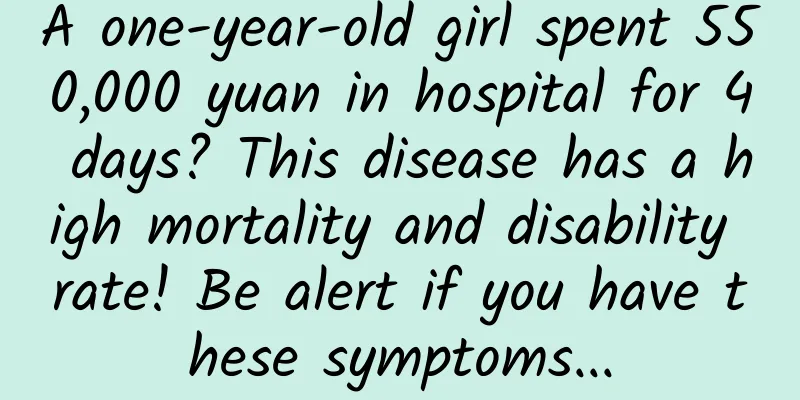A one-year-old girl spent 550,000 yuan in hospital for 4 days? This disease has a high mortality and disability rate! Be alert if you have these symptoms...

|
Expert of this article: Zhao Wei, deputy chief physician of Department of Neurology and Sleep Medicine Center, Tianjin University Teda Hospital Recently, a piece of news "A one-year-old child spent 550,000 yuan on medical expenses during four days of hospitalization" attracted people's attention. News screenshots According to the hospitalization fee receipt of the Pediatric Neurorehabilitation Ward of the Second Affiliated Hospital of Xi'an Jiaotong University, the young girl was hospitalized for four days from August 17 this year to August 21, with a cost of 550,000 yuan. The parents said in an interview afterwards that they were aware of the whole process. Source of the photoshopped receipt: China Youth Daily It is reported that the above-mentioned child went to the hospital for treatment due to weak limbs and backward motor skills. Eventually, experts from various fields diagnosed him with spinal muscular atrophy (SMA), a rare genetic disease. So, what is spinal muscular atrophy? Why is the cost of treatment so high? What other rare diseases are there in children? Let's take a look. What is spinal muscular atrophy? The cause of spinal muscular atrophy (SMA) is unknown, but it is often associated with genetic defects in the gene encoding the survival motor neuron protein. This genetic defect results in loss of function of motor neurons in the anterior horn of the spinal cord and the medulla oblongata. The motor neurons in the anterior horns of the spinal cord control skeletal muscle movement, and loss of motor function will result in atrophy of muscles throughout the body; The motor neurons in the medulla oblongata control a person's respiratory muscles, and breathing difficulties can easily occur if they are affected. The clinical manifestations of spinal muscular atrophy are progressive, symmetrical muscle weakness and atrophy of the proximal limbs and trunk. Eventually, patients may lose basic life functions such as mobility, breathing and swallowing. The incidence rate of newborns is about 1/10,000, ranking first among fatal genetic diseases for children under 2 years old. According to the normal birth rate in China, there are about 2,000 new cases of spinal muscular atrophy in China each year, and the current number of patients is about 50,000. What drugs are used to treat spinal muscular atrophy? Why are they so expensive? Nusinersen is the world's first and currently the only drug for the treatment of spinal muscular atrophy. It can regulate RNA function, correct genetic information, change protein expression, and increase the protein encoding survival motor neurons. In the United States, the cost of nusinersen is about $125,000 per injection, which is quite expensive, and the first-year treatment cost is about $750,000 (about RMB 5.2 million). When nusinersen was launched in China in 2019, the cost in the first year was about RMB 4 million, and about RMB 2 million per year thereafter. In addition to nusinersen, Roche Pharmaceuticals' oral drug lisapram can also increase the level of survival motor neuron protein in the body, improving motor function, breathing and swallowing, etc. The annual cost of this drug ranges from about 300,000 yuan to 1 million yuan. Currently, a drug called Zolgensma, which uses viral vector gene therapy to treat spinal muscular atrophy, is produced by a US pharmaceutical giant. It can repair related gene defects with a single intravenous administration, which is good news for patients with spinal muscular atrophy and their families. However, the price of this drug is astronomical, as high as 2.1 million US dollars (about 14.48 million RMB). What symptoms should you be alert to? Spinal muscular atrophy mainly affects infants and young children. The younger the age of onset, the higher the mortality rate. It can be divided into four types according to the course of the disease: a. Acute infantile The disease usually occurs 3 to 6 months after birth. Symptoms include weakness of the proximal limbs, inability to raise the head and flex the neck, and difficulty in feeding. Death often occurs due to repeated respiratory infections, with an average survival period of 7 to 9 months. b. Chronic infantile type The disease usually occurs between 6 months and 2 years old after birth. The main symptom is symmetrical weakness of the proximal limbs, which is more severe in the lower limbs than in the upper limbs. Most patients can survive into adolescence. c. Juvenile type Most of them develop in childhood or adolescence. They often start with lower limb muscle weakness, with difficulty walking, standing, and climbing stairs, and gradually affect the upper limbs. Most patients need to use a wheelchair when they are 30-40 years old, but some develop slowly. d. Adult type The onset age is relatively late. Clinical manifestations are mainly proximal limb muscle atrophy and weakness. Dysarthria (muscle paralysis of the vocal organs leads to speech disorders), dysphagia and dyspnea may occur. This type of patient has a good prognosis and most have a benign course. Because spinal muscular atrophy is a serious disease with high mortality and disability rates, and expensive treatment costs, the emphasis is on prevention: prenatal genetic screening. What other rare childhood diseases are there? Rare diseases refer to diseases in which the number of patients accounts for 0.65‰ to 1‰ of the total population. Currently, there are more than 7,000 confirmed rare diseases in the world, accounting for about 10% of the total number of human diseases. In 2018, our country tentatively finalized the first list of rare diseases, which collected a total of 121 clinically rare diseases. Due to my country's large population and the advancement of diagnostic technology, rare diseases are not rare in my country. About 56.9% of rare diseases occur in children. "Butterfly Baby", "Beautiful Child", "Porcelain Doll", "Panda Baby", albinism, phenylketonuria, mitochondrial disease, etc. are all pediatric rare diseases. In summary Spinal muscular atrophy It is a genetic disease High mortality and disability rates Treatment is expensive Most importantly Prenatal genetic screening Expert in this article: Zhao Wei, deputy chief physician of the Department of Neurology and Sleep Medicine Center, Tianjin University Teda Hospital Source: Science Popularization China |
<<: Why should we drink enzymes? How to eat enzyme jelly correctly
>>: When is the best time to take enzymes? Benefits of taking enzymes for women
Recommend
What is the cause of the coffee-colored vaginal discharge after menstruation?
Speaking of menstruation, actually every girl wil...
How harmful is vaginal ultrasound in early pregnancy?
Vaginal ultrasound is also a type of gynecologica...
Stomach pain after urinating
Many diseases and problems often occur in people&...
What leads to pregnancy?
Pregnancy is a happy thing for many people, becau...
China Unicom: In October 2012, Unicom's operating data showed that Unicom's 3G users had increased to 70.067 million.
On November 19, 2012, China Unicom announced toda...
A 1-month-old baby suddenly had intracranial hemorrhage. What happened?
Dangerous experience One-month-old Niu Niu is the...
How to make chrysanthemum porridge? How to brew chrysanthemum tea?
Chrysanthemum ranks third among the top ten famou...
How many times does a woman ovulate in her lifetime?
When is the ovulation period in a woman's lif...
Why does the lotus root powder come out in clumps? Is there any way to remedy the problem?
When making lotus root powder, sesame paste, kudz...
Menstrual period precautions
During the menstrual period, women's physical...
How to clear fallopian tube adhesions?
Some female patients have problems with their fal...
Does a small amount of pelvic effusion require treatment?
Many women suffer from gynecological inflammation...
Why are there worms in cherries? Can worms in cherries be eaten?
As the cherry season arrives, more and more artic...
What medicine is good for women with frequent urination and urgency?
Women are more susceptible to urinary tract infec...









